Biology Unit 6 (Ecology) Test Review
1/68
Name | Mastery | Learn | Test | Matching | Spaced |
|---|
No study sessions yet.
69 Terms
The 8 levels of Biological Organization, from smallest to largest
Molecule (ex. H2O)
Cell (ex. skin cell)
Group of cells (ex. brain)
Organism (ex. bison)
Population (ex. herd of bison)
Community (ex. grass, prairie dog, bison, snake, hawk)
Ecosystem (ex. grass, prairie dog, bison, snake, hawk, stream, rocks, air)
Biosphere (all ecosystems collectively)
Ecology
Study of the interactions among organisms and between organisms and their environment
What is the main source of energy in an ecosystem?
The sun
Autotroph
An organism that creates its own food (examples: plants, some algae, some bacteria) also known as a producer
Heterotroph
An organism that must consume other organisms to survive (animals) also known as a consumer
Photosynthesis vs. Chemosynthesis
Photosynthesis is powered by sunlight while chemosynthesis runs on chemical energy.
Herbivores
Heterotrophs that only consume plants (examples: cows, deer, rabbits)
Carnivores
Heterotrophs that only consume meat (examples: lions, sharks, eagles)
Omnivores
Heterotrophs that consume both plants and animals (examples: bears, foxes, most humans)
Detritivores
Heterotrophs that consume dead things (examples: crabs, sea cucumbers, slugs)
Decomposers
Organisms that break down dead things (examples: mushrooms, bacteria)
Food chain
Series of steps where organisms pass on energy by eating and get eaten, in which the arrows point to where the energy is being transferred (the predator)

Biological Magnification
How concentrations of toxins increase in each trophic level, so that top-level predators are the most affected
How much energy is passed from trophic level to trophic level?
Only 10% of the energy in a trophic level is passed on to the next trophic level
Energy Pyramid
A pyramid that shows how energy is passed down to higher trophic levels

Biomass Pyramid
Shows the total amount of living tissue within each trophic level
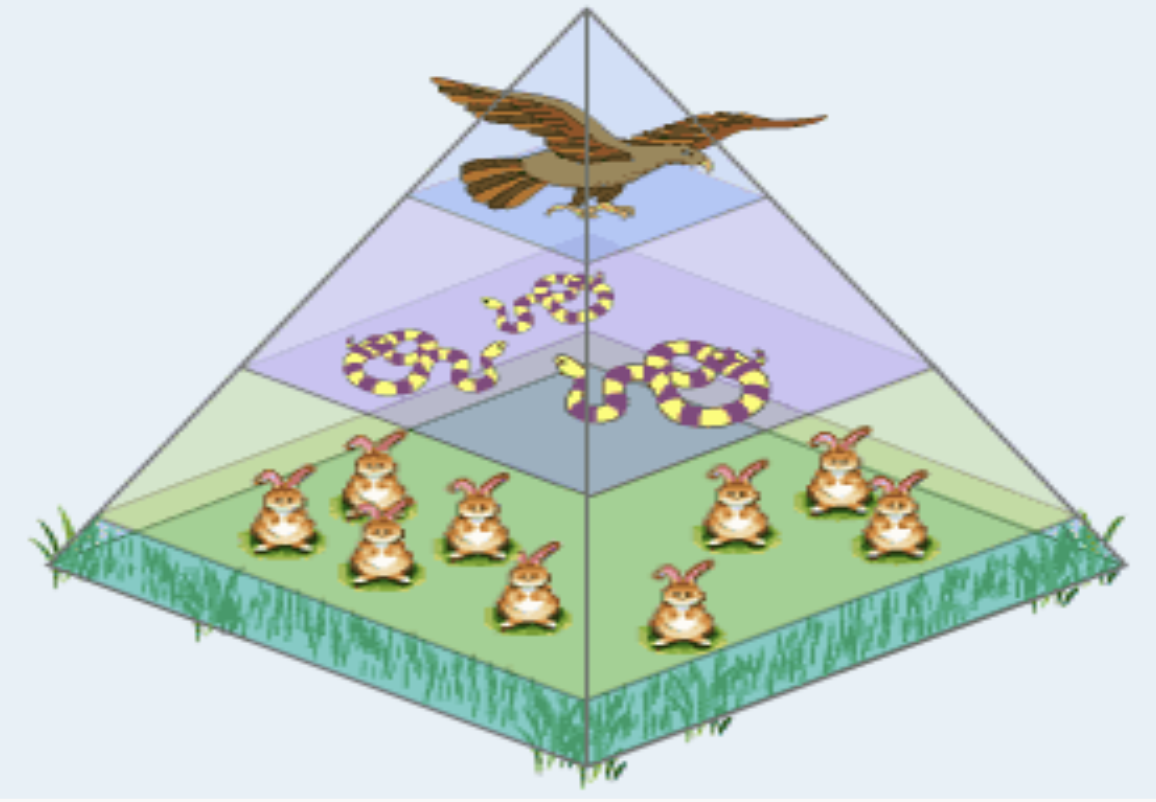
Pyramid of Numbers
Shows the number of individual organisms at each level (might not always be a perfect pyramid shape)
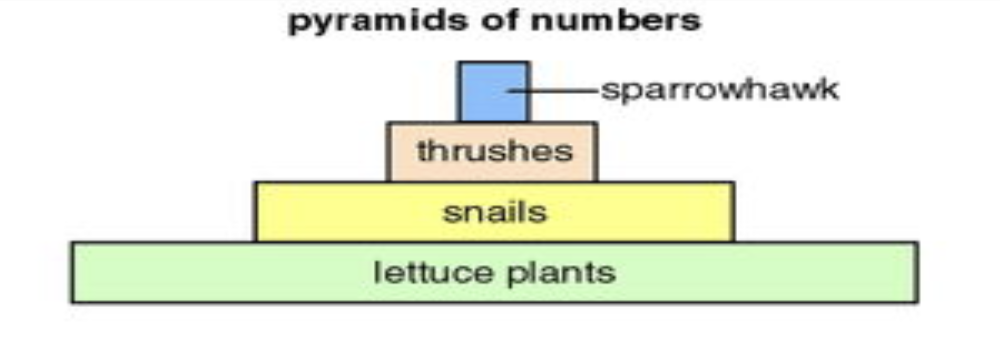
How does matter move through an ecosystem?
Unlike energy (which is a one-way flow), matter is recycled within and between ecosystems
What are the 7 stages of the hydrologic (water) cycle?
Precipitation (water falling from the sky, e.g. rain, snow, hail)
Transpiration (water evaporating from plants)
Evaporation (water turning into vapor and rising into the sky)
Condensation (water vapor forming into clouds)
Surface runoff (water running off surfaces)
Seepage (water seeping into the ground)
Uptake (groundwater moving up into plants)
What are the 3 main nutrient cycles we studied?
Carbon cycle
Nitrogen cycle
Phosphorus cycle
Why are nutrients recycled?
Nutrients are often in short supply in a particular ecosystem
Nutrient cycling keeps many chemicals from reaching concentrations that would otherwise be toxic, or harmful, to organisms
How are some ways that carbon is recycled?
Photosynthesis
Volcano eruptions
Creation of fossil fuels
Human activity (cutting/burning forests, combustion of fossil fuels)
Why is nitrogen so important for living things?
Nitrogen is an essential component of amino acids, which are used to build proteins
Nitrogen fixation
When bacteria that live on the roots of legumes (beans, peas, etc.) take nitrogen from the air and convert it to forms of nitrogen that plants can use
Denitrification
When bacteria in the soil convert nitrogen in the soil into nitrogen gas (essentially the opposite of fixation)
Why is phosphorus so important to living things?
It’s needed for ATP
What makes the phosphorus cycle different from the other two?
Phosphorus never enters the atmosphere
Limiting nutrient
Nutrients that can limit productivity in a given ecosystem based on its availability (example: nitrogen, phosphorus, and potassium are limiting nutrients for farmland because they are needed to make fertilizer)
Bloom
When there’s a sudden influx of limiting nutrients, disrupting the balance of an ecosystem
Niche
Where and how an organism lives; the way it uses available resources
Competition
When organisms attempt to use the same resource in the same place at the same time
Predation
Interaction where one organism feeds on the other
How does the amount of prey affect the amount of predators?
More prey → more predators
More predators → less prey
Less prey → fewer predators
Fewer predators → more prey
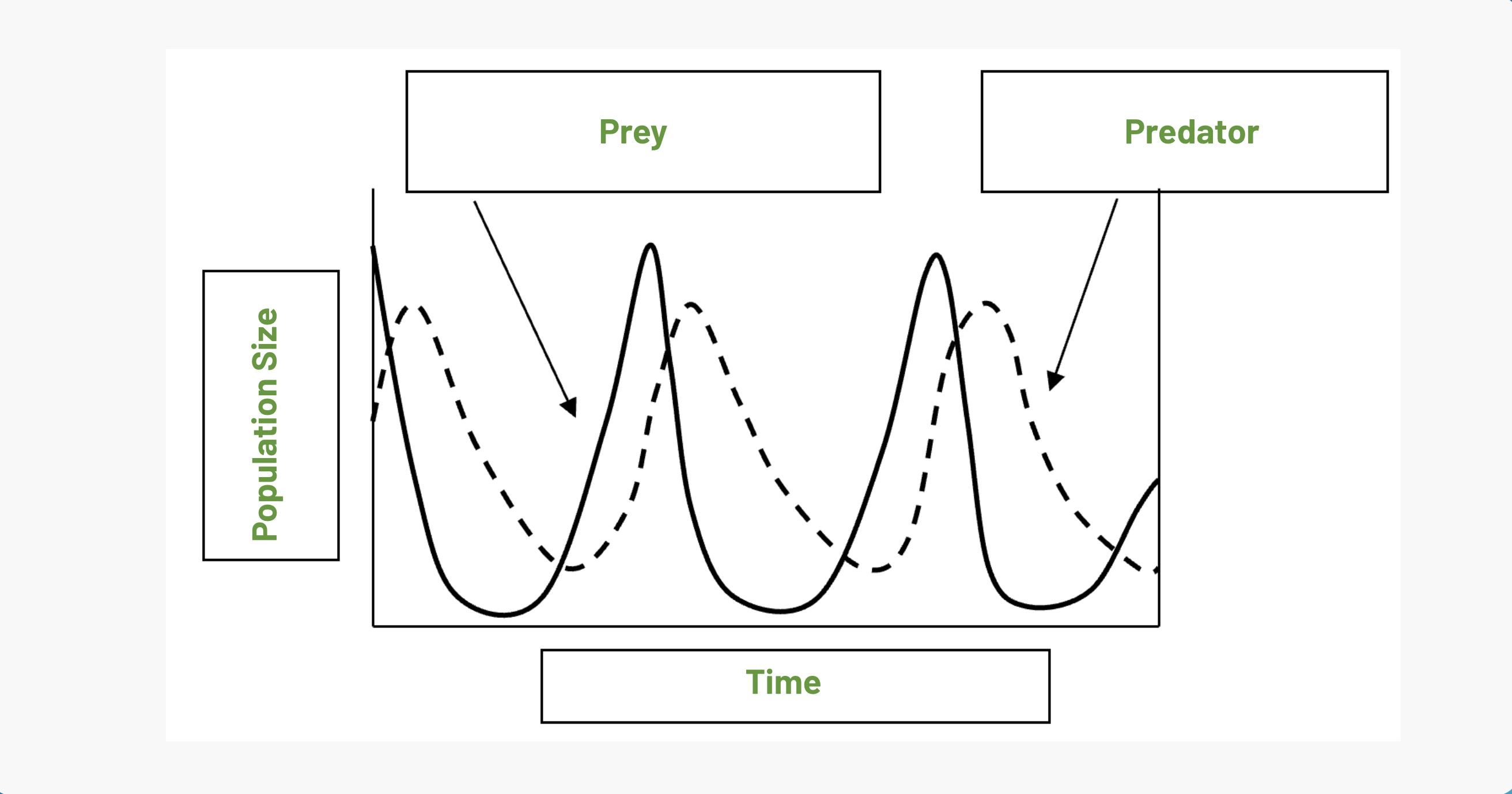
Symbiosis
A relationship in which two different species live together
Mutualism
A symbiosis relationship in which both species are benefitted (example: clownfish and sea anemone)
Commensalism
A symbiosis relationship in which one species is benefitted and the other is unaffected (example: barnacles and whale)
Parasitism
A symbiosis relationship in which one species harms the other by living on or in it (example: tapeworms)
Ecological succession
The gradual change in living communities following a disturbance, such as a natural disaster
Primary succession
Succession on newly exposed surfaces, where the soil was destroyed (example: lava field)
Secondary succession
Succession after a disturbance that didn’t destroy the soil (example: abandoned farmland)
Limiting factor
A factor that decreases growth (examples: competition, predation, parasitism, human disturbances)
Density-dependent limiting factor
A limiting factor that’s dependent on population size (examples: Predation, competition, pollution)
Density-independent limiting factor
A limiting factor that affects all populations in similar ways, regardless of the population size (examples: natural disasters, seasonal cycles, human activities such as building dams)
Trophic cascade
When changes in the population of one species lead to changes in populations of species at other trophic levels in a food chain or food web
What is the connection between the wolves and rivers at Yellowstone?
When the wolves were initially removed, the amount of herbivores increased because of the lack of predators, which ate up the vegetation and caused the rivers to erode. When the wolves were reintroduced, the amount of herbivores decreased again, which made the rivers go back to normal too.
What is the relationship between the wildebeest and plant populations in the Serengeti?
The wildebeest eating the dry grass caused the amount of wildfires to decrease, which caused the tree population to increase
Population size vs. population density
The size is the total number of individuals in a population, while the density is the number of individuals is the amount per a given unit of area
Age structure
The number of individuals at different ages (the ones at a reproductive age are especially important)
Geographic distribution
A range of where organisms live
Growth rate
How fast organisms reproduce
What 4 factors impact population size?
Birth
Death
Immigration (organisms entering an area)
Emigration (organisms leaving an area)
Population size increases when…
↑ birth rate, ↓ death rate
↑ immigration, ↓ emigration
Population size decreases when…
↓ birth rate, ↑ death rate
↓ immigration, ↑ emigration
Exponential Growth
When individuals reproduce at a constant rate, forming a J-shaped graph
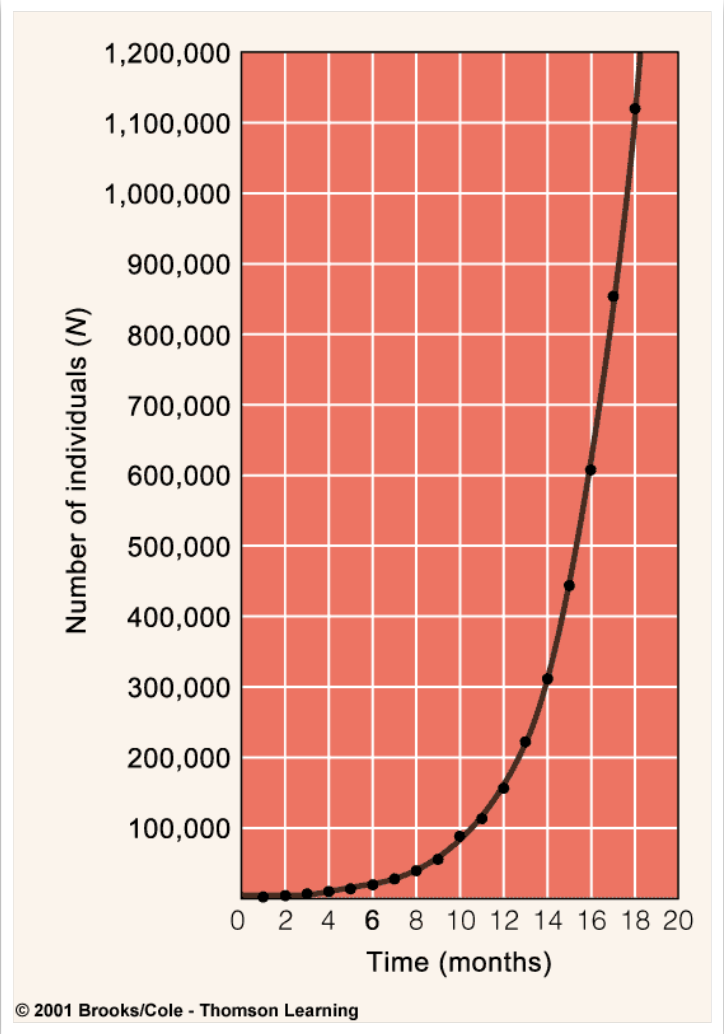
Logistic Growth
Growth that’s initially exponential, but then resources get used up, slowing growth and forming an S-shaped graph
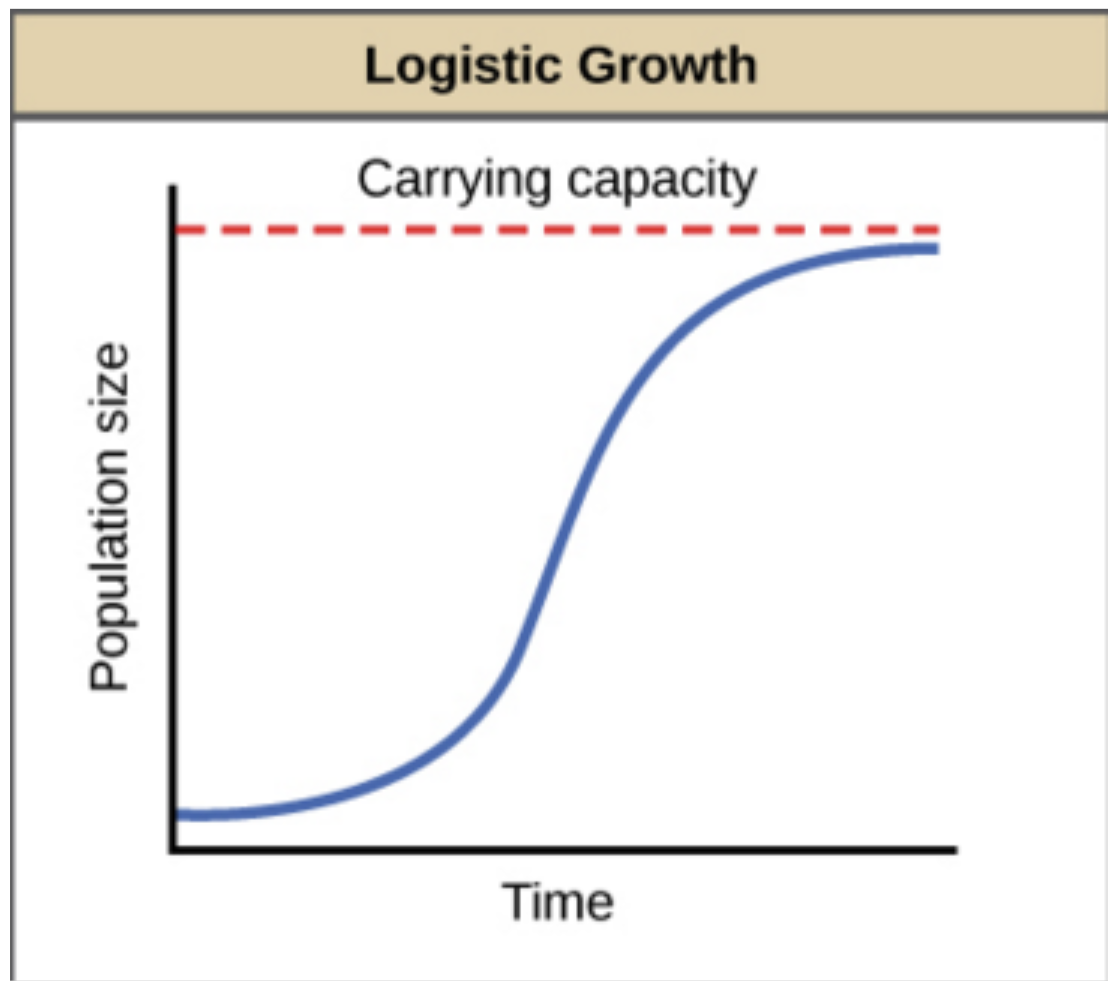
Keystone species
An organism that plays a major role in keeping an ecosystem balanced; it helps define said ecosystem
Green world hypothesis
A hypothesis that suggests that predators are the main regulators of ecosystems because they prevent herbivores from eating all the vegetation
Demography
The study of human populations
Demographic transition
A shift from high birth and death rates to low birth and death rates, resulting in little to no population growth
What do different age structure diagrams look like?
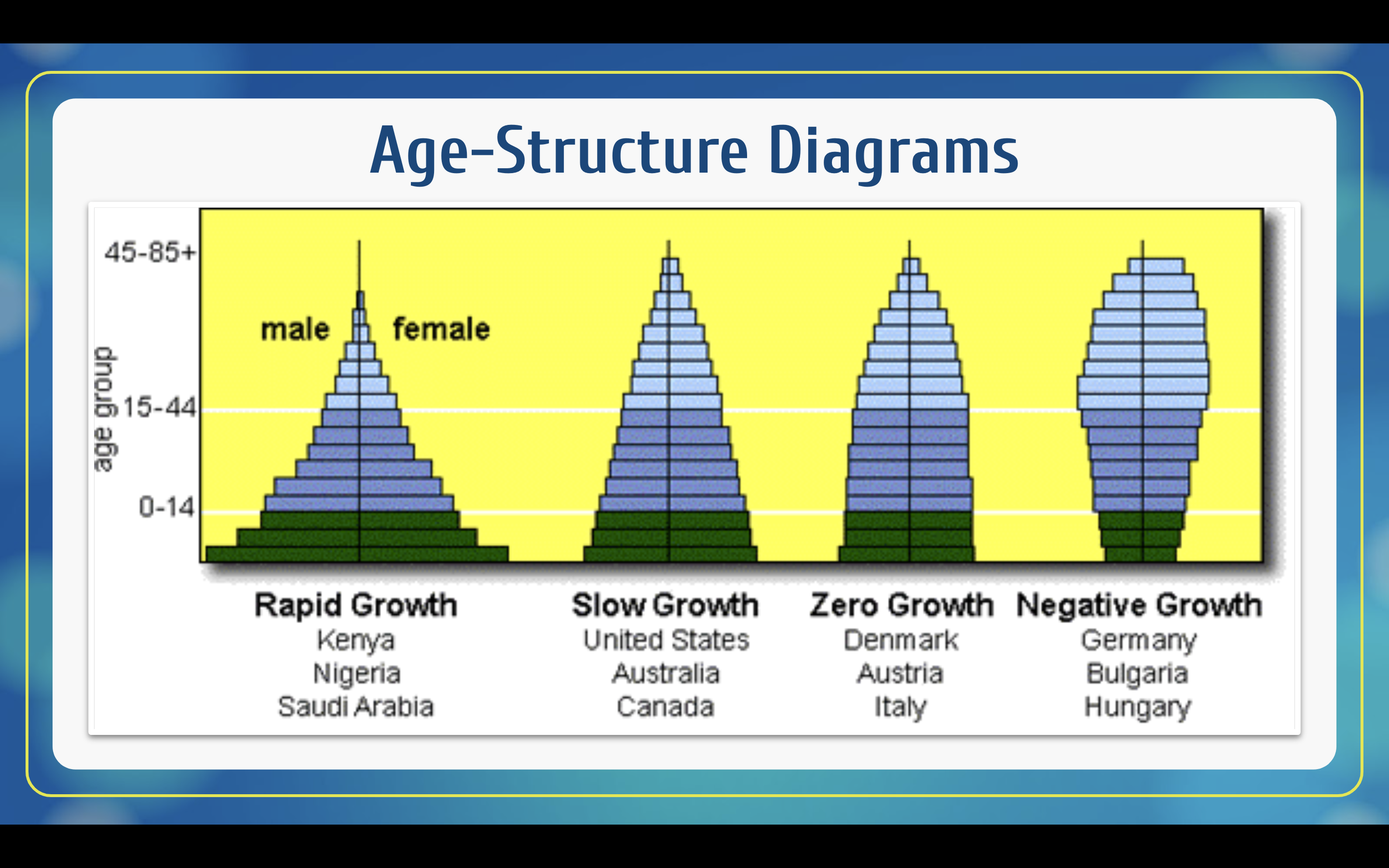
Weather vs. Climate
You can’t weather a tree, but you can climate! (climb it)

Weather vs. Climate (for real this time)
Weather changes from day to day while climate is the average condition from year to year in a certain region
What causes climate?
Heat trapped by atmosphere
Latitude
Winds and ocean
currentsPrecipitation
Landmasses—shape
and elevation
Greenhouse effect
The atmosphere traps heat on Earth to keep it suitable for life as we know it
What are the three main greenhouse gasses?
Carbon dioxide
Methane
Water vapor
Tragedy of the Commons
The idea that resources that are available to everyone but nobody’s responsible for will eventually be destroyed
Renewable vs. nonrenewable resources
Renewable resources are limited but can be regenerated, while nonrenewable cannot be replenished
Sustainable use
A way of using natural resources at a rate that does not deplete them (examples: recycling, solar power, composting)
What is the main argument that the Kiss the Ground documentary makes for fighting climate change?
The ground plays a key role in reversing climate change, and that anyone can help